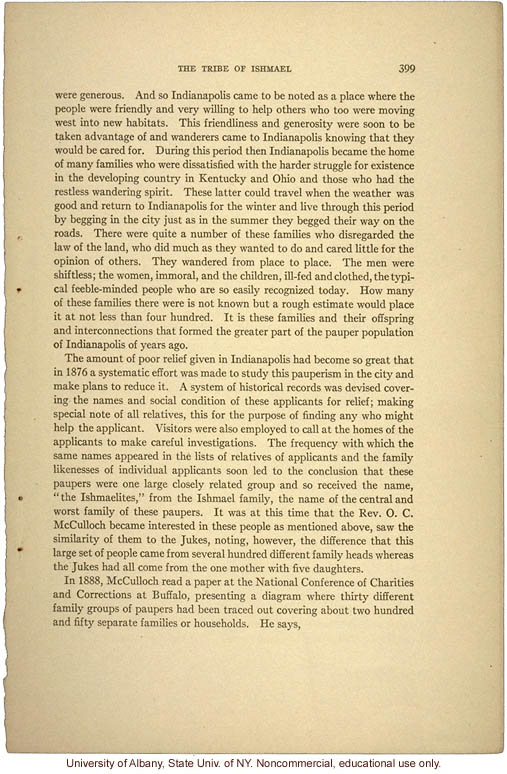The Tribe of Ishmael 399
were generous. And so Indianapolis came to be noted as a place where the people were friendly and very willing to help other who too were moving west into new habitats. This friendliness and generosity were soon to be taken advantage of and wanderers came to Indianapolis knowing that they would be cared for. During this period then Indianapolis became the home of many families who were dissatisfied with the harder struggle for existence in the developing country in Kentucky and Ohio and those who had the restless wandering spirit. These latter could travel when the weather was good a return to Indianapolis for the winter and live through this period by begging in the city just as in the summer they begged their way on the roads. There were quite a number of these families who disregarded the law of the land, who did much as they wanted to do and cared little for the opinion of others. They wandered from place to place. The men were shiftless; the women, immoral, and the children, ill-fed and clothed, the typical feeble-minded people who are so easily recognized today. How many of these families there were is not known but a rough estimate would place it at not less than four hundred. It is these families and their offspring and interconnections that formed the greater part of the pauper population of Indianapolis of years ago.
The amount of poor relief given in Indianapolis had become so great that in 1876 a systematic effort was made to study this pauperism in the city and make plans to reduce it. A system of historical records was devised covering the names and social conditions of these applicants for relief; making special note of all relatives, this for the purpose of finding any who might help the applicant. Visitors were also employed to call at the homes of the applicants to make careful investigations. The frequency with which the same names appeared in the lists of relatives of applicants and the family likenesses of individual applicants soon led to the conclusion that these paupers were one large closely related group and so received the name, "The Ishmaelites," from the Ishmael family, the name of the central and worst of these paupers. It was at this time that the Rev. O. C. McCulloch became interested in these people as mentioned above, saw the similarity of them to the Jukes, noting, however, the difference that this large set of people came from several hundred different family heads whereas the Jukes had all come from the one mother with five daughters.
In 1888, McCulloch read a paper at the National Conference of Charities and Corrections at Buffalo, presenting a diagram where thirty different family group of paupers had been traced out covering about two hundred and fifty separate families or households. He says,
[end]


